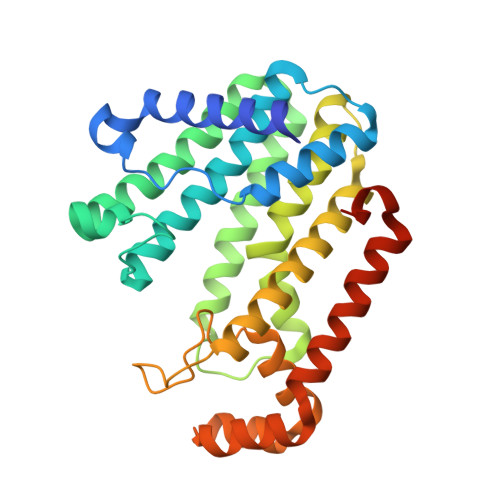A molecular ruler for chain elongation catalyzed by octaprenyl pyrophosphate synthase and its structure-based engineering to produce unprecedented long chain trans-prenyl products
Guo, R.T., Kuo, C.J., Ko, T.P., Chou, C.C., Liang, P.H., Wang, A.H.-J.(2004) Biochemistry 43: 7678-7686
- PubMed: 15196010
- DOI: https://doi.org/10.1021/bi036336d
- Primary Citation of Related Structures:
1VG2, 1VG3, 1VG4, 1VG6, 1VG7 - PubMed Abstract:
Octaprenyl pyrophosphate synthase (OPPs) catalyzes consecutive condensation reactions of farnesyl pyrophosphate (FPP) with five molecules of isopentenyl pyrophosphate (IPP) to generate C(40) octaprenyl pyrophosphate (OPP) which constitutes the side chain of menaquinone. We have previously reported the X-ray structure of OPPs from Thermotoga maritima, which is composed entirely of alpha-helices joined by connecting loops and is arranged with nine core helices around a large central cavity [Guo, R. T., Kuo, C. J., Ko, T. P., Chou, C. C., Shr, R. L., Liang, P. H., and Wang, A. H.-J. (2004) J. Biol. Chem. 279, 4903-4912]. A76 and S77 are located on top of the active site close to where FPP is bound. A76Y and A76Y/S77F OPPs mutants produce C(20), indicating that the substituted larger residues interfere with the substrate chain elongation. Surprisingly, the A76Y/S77F mutant synthesizes a larger amount of C(20) than the A76Y mutant. In the crystal structure of the A76Y/S77F mutant, F77 is pushed away by Y76, thereby creating more space between those two large amino acids to accommodate the C(20) product. A large F132 residue at the bottom of the tunnel-shaped active site serves as the "floor" and determines the final product chain length. The substitution of F132 with a small Ala, thereby removing the blockade, led to the synthesis of a C(50) product larger than that produced by the wild-type enzyme. On the basis of the structure, we have sequentially mutated the large amino acids, including F132, L128, I123, and D62, to Ala underneath the tunnel. The products of the F132A/L128A/I123A/D62A mutant reach C(95), beyond the largest chain length generated by all known trans-prenyltransferases. Further modifications of the enzyme reaction conditions, including new IPP derivatives, may allow the preparation of high-molecular weight polyprenyl products resembling the rubber molecule.
Organizational Affiliation:
Taiwan International Graduate Program, Academia Sinica, Taipei 115, Taiwan.














